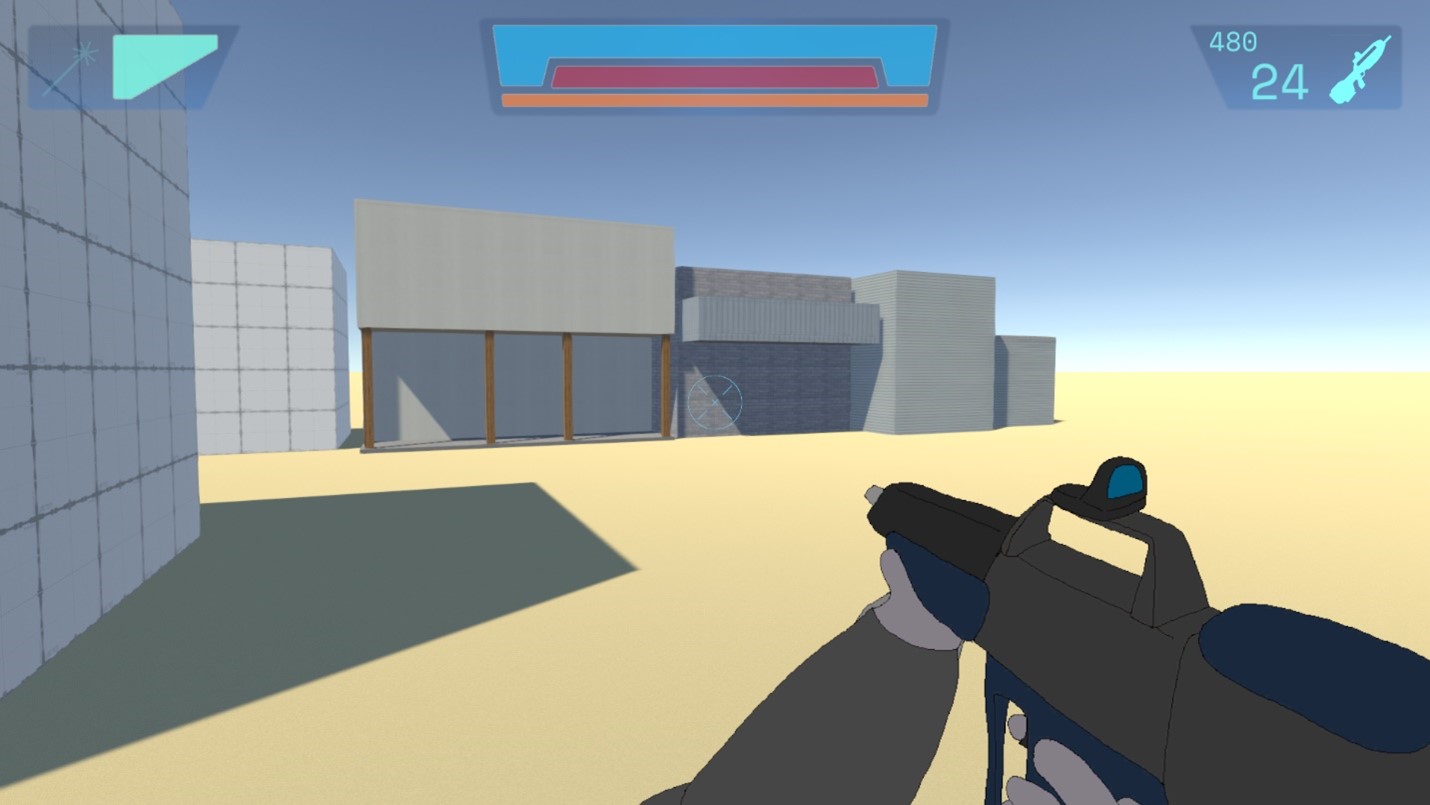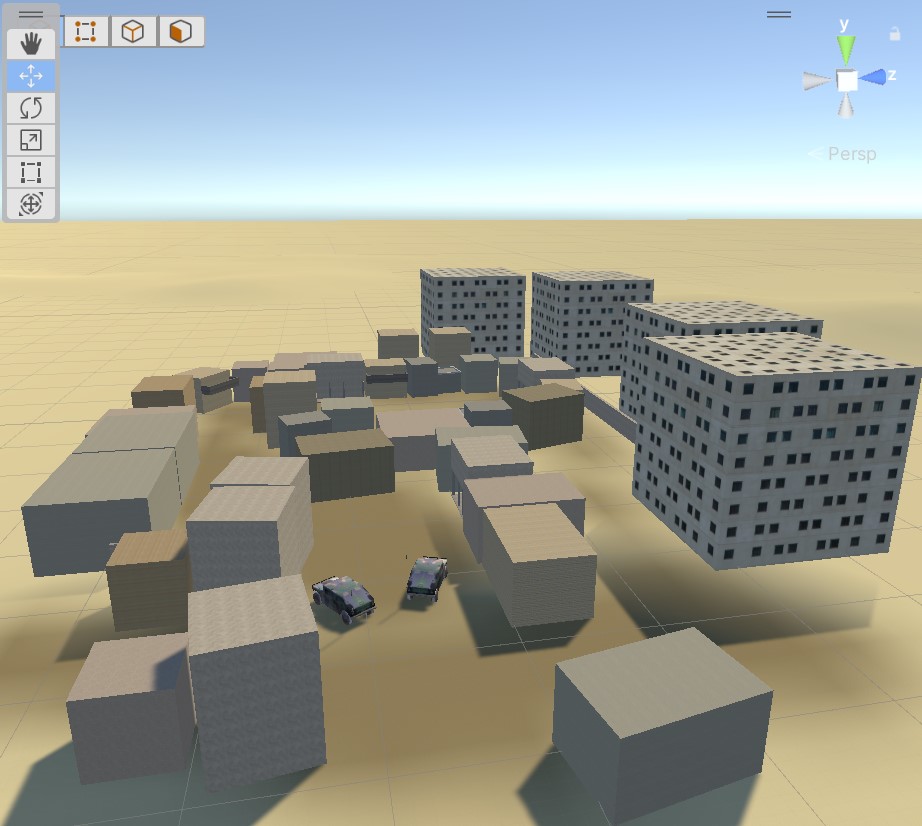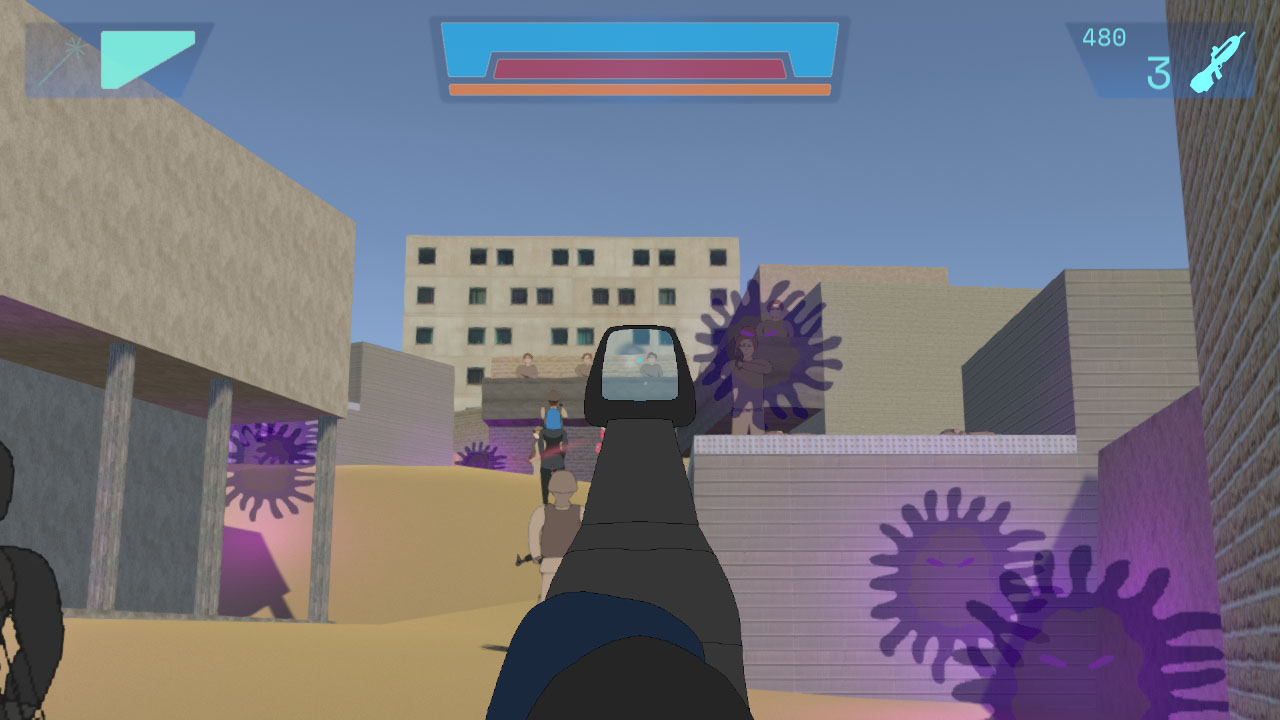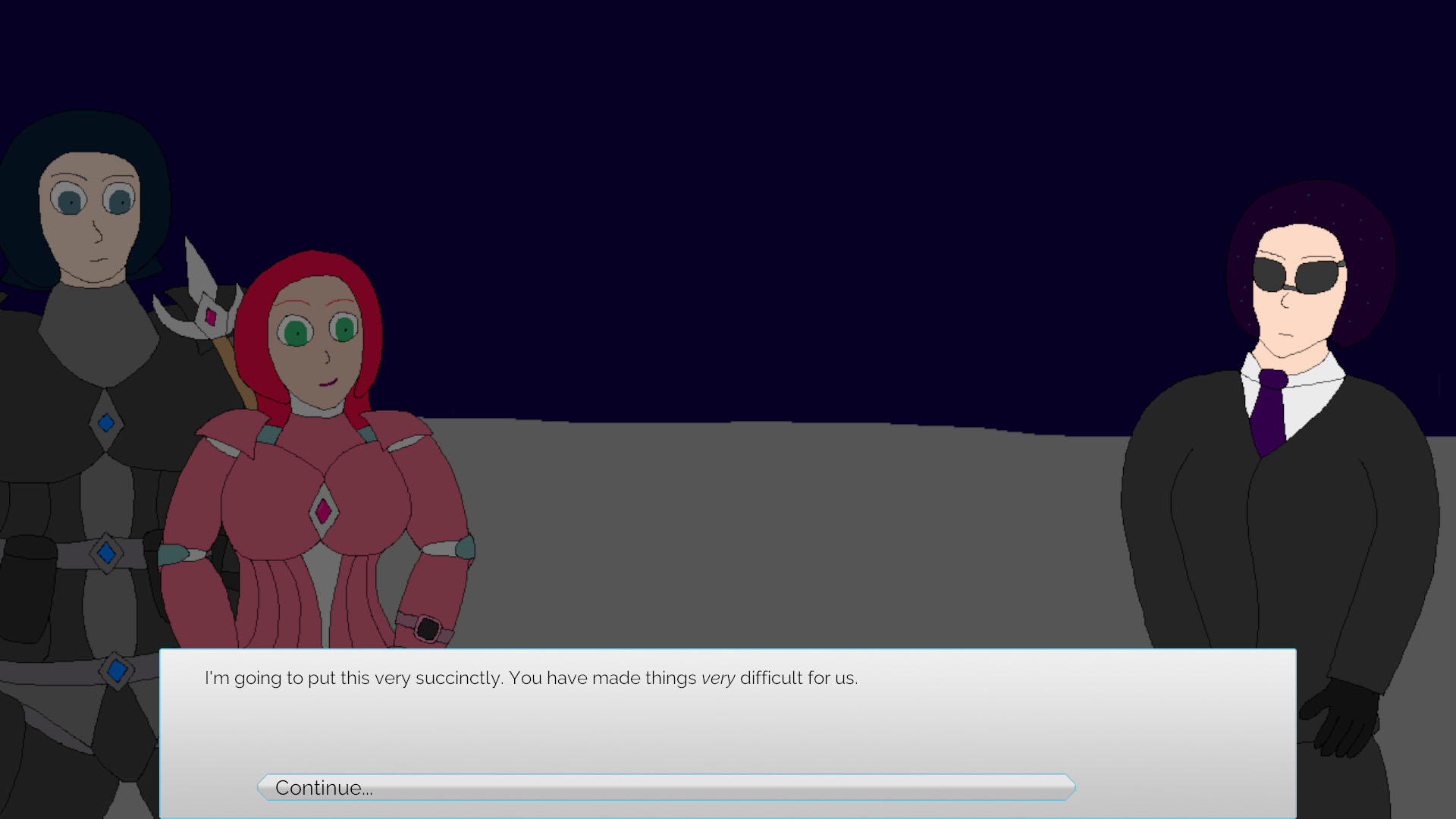Project Daybreak Demo Postmortem
After months of development, the first playable demo is finally here! I’m super excited about this project, because it’s one I’ve wanted to do for a long time. Let’s dive into where this came from, how it went, and where it’s going.
A long time coming

I almost made this game for MGGJ9. The timing was about right; I had “third Magical Girl Gina game” in mind but hadn’t started it yet, and some of the themes lined up with the ideas I had. There was no way the whole game would be finished for MGGJ9, to be clear, but I’d be happy to just get a demo done and finish it after the fact since it’s a game I wanted to make anyway.
Ultimately, I had too many other things going on and it didn’t happen. But the Continue-It Jam was timed about perfectly: I’d finished up most of the other stuff I had on my plate by then. Technically, I started before the Continue-It Jam had formally launched, but I really ramped things up once it started. The length of the jam was about perfect to get a meaningful chunk of the game put together.
I’ve actually been thinking about this project in one form or another since before At the Break of Dawn even launched. I just never really had a chance to really start working on it, especially once I started pulling back from game dev and limiting the time I spent on it. And, once I decided to write Gap Year, this ended up kind of stuck behind that (while it’s not finished at the time of writing, it will be before this game launches).
I’ve had a lot of disparate ideas and a rough idea of the overall narrative, but it was only once I started working on it this year that I really started nailing down some of the key plot points, exactly what missions were going to be in the game, and how it was going to play. Because of that- and because a lot of the earlier ideas were just way too ambitious- it sometimes feels like I’m making an adaptation of something that already exists.
(Although it’s heavily influenced by Call of Duty and other Modern Military Shooters (tm), I promise this one isn’t actually a straight knockoff of anything)
For most of its life, this project was known by its codename Big Team Heavies, and sometimes as Suckerpunch 3 or Outliers 3 until finally getting its current working title: Project Daybreak. So you may see oblique references to it under other names here and there.
A quick recap: Magical Girl Gina

I’m expecting most of the audience of this jam to be familiar with the series (formally known as Outliers and Outsiders), but for those coming in from elsewhere, I’ll quickly recap it here.
Outliers and Outsiders (sometimes referred to as the Magical Girl Gina series) is a series that grew out of a salvaged project for Magical Girl Game Jam 2. Nominally in the magical girl genre, it departs from several genre conventions and is heavily influenced by superhero fiction, with notes of urban fantasy and magical realism. It’s also set in the doldrums of the 2020s, with the first game at the height of the pandemic. Most of the games are first-person shooters, but there’s also a visual novel (ish) spinoff. There’s also an illustrated novella, with two out of three parts done and the third nearing completion at the time of writing.
It’s a continue-it jam, not a finish-it jam

It’s a good thing it’s a “continue-it” jam and not a “finish-it” jam, because I knew I couldn’t finish the game in one go. The overall scope is bigger than AtBoD but not dramatically so, and I managed to hack together that together in a month for MGGJ4, but I’m in a much different place as a creator, and that’s not a pace I can manage today.
I decided to try to finish the first third to half of the game. There’s a timeskip in the middle of the story that makes a great spot to stop. When I say finish, I mean get to 95% complete, with all the gameplay, graphics, and audio that will be in the final game (barring some necessary tweaks). That added up to two short levels (one including an interior section), intro and titles sequences, and a few conversation sequences.
At the formal start of the Continue-It Jam on April 24, I was just finishing up with my assets mini-sprint and moving on to starting to build the game itself. By that point I’d also finalized most of the story beats and decided which missions were going to be in the game.
Assets first

Let’s talk about that assets mini-sprint a bit, because it’s something new I tried for this project. I’ve found it really kills my momentum to be working on the environments and gameplay and then have to pause to create assets that don’t exist yet. For example, if I’m adding enemies into a level I’ll either need to have the sprites first or dig out placeholders and replace them later, and the visual novel style dialogue is difficult to arrange properly without having sprites at the final sizes.
This time around, I had a pretty good idea of what I would need early on, so I could front-load the process and get a lot of that out of the way and ready to go early on. I spent a few weeks on this part of the process, only poking at the game itself and instead doing a lot of drawing. I had some earlier drawings to work from for both the world and dialogue sprites, which was definitely helpful.
It did start to get a bit tedious and monotonous towards the end, though, especially with the many rotations for character sprites. That’s the downside of this approach, not being able to do a little bit and then do something else. I got through it, but I think I was pretty close to the limit of how much I could do this way.
I did briefly consider abandoning the idea of having visual novel style dialogues with character busts so I could reuse the western RPG style portraits from the previous games.
I would say about 70% of the graphical assets I need to draw are now done. That includes nearly all world sprites, most but not all of the dialogue sprites, and some of the drawn cutscenes, dialogue backgrounds and flavour graphics. I did some of those after the assets mini-sprint when I was already working on the game itself, and that initial effort made it a lot more manageable. I did also dig up some of the sound effects and put together some of the visual effects during the assets mini-sprint, which helped, too.
Let's build!

The hardest part of this project from its inception has been to just start working on things and keep momentum going. To be honest, that’s something I struggle with in general these days. I promise I’ll cover that in its own post someday.
Having the majority of the graphical assets put together and ready to go definitely helped. For the most part, I didn’t have to worry about those, especially for the gameplay segments. I could focus on building the environments, populating them, and setting up the gameplay sequences.
There’s really nothing new here in terms of tools or techniques. Actor logic, including the follower tethers, is all part of CommonCore and hasn’t changed much since the last game in the series. There’s a script full of coroutines, switching based on quest state, that drives all the “sequencing” in the level: make these guys go here, wait for the player to enter an area, show a dialogue.
There is one change: this game will only have fixed checkpoints rather than being able to save at any time. This just simplifies those sequence scripts a bit, cutting out some edge cases around handling things that get automatically restored and things that don’t. I think the levels are short enough that it’s not going to be an issue, and I’ve added a few checkpoints in strategic spots for good measure.
The level geometry itself is mostly built with ProBuilder. I don’t love the tool, its usability hasn’t improved in years and might have gotten worse, but it hits the right balance of powerful enough and I’m used to it. I’ve gotten a lot more comfortable with the Unity Terrain system in recent years, so I used it this time and I think every exterior level in the game probably will. The levels are pretty barebones, and I’m not sure how much if any detailing will be added later.
Honestly, it went surprisingly smoothly. I’m not entirely happy with how some of the gameplay turned out- we’ll see how much room we have to tweak it later- but getting things built and working went pretty smoothly. I spent about a month on it, but in terms of actual hours worked on it, not that many (I didn’t track it, maybe I should have).
Fun fact: Project Daybreak is literally built on top of The Crystal Tower. I copied the project, deleted everything I didn’t think I would need, upgraded Unity and CommonCore, renamed some things and fixed the errors, added back the things I didn’t think I would need but actually did, and went from there. Obviously, this isn’t a good way of doing things, but with only three more games planned on this stack I’m past the point of caring.
Scope, scope, scope

I think another reason why making this game feels like making an adaptation has to do with the constant battle to keep scope in check. This is probably going to be the last Magical Girl Gina game for a while and it’s one I’ve been excited about for years, so I want to do it justice. At the same time, I want to actually finish it and not burn myself out in the process.
I tend to start with an ambitious concept and then pare it down to something workable, though the first Magical Girl Gina game was an exception to this. This time, I had a lot of loose ideas and started thinking about scope when I started nailing down what missions were going to be in the game. We’ll see for sure once they’re implemented, but I think I did a good job balancing making things interesting, keeping them doable, and carrying the right story beats. There are five planned in total (with two in the demo) mostly pretty short but set in a variety of environments with a few interesting gameplay sections planned.
I found myself always looking for things to cut and shortcuts to take when I started working on this project. I definitely feel like I’ve overscoped it even with the limited mission count, but I also don’t think it can be any shorter and be a complete game. There was a sixth mission that I started to plan, but I decided to axe it pretty quickly because it seemed like a lot of effort for a concept that wasn’t that interesting and didn’t add much to the story.
There is one pretty major change made mostly to limit scope: you can’t import your previous saves, and it’s not a branching narrative. I think trying to carry forward pivotal decisions was way too ambitious in the first place, and doesn’t really work with where I want to take the series. We’ve already had to trim the branches: you can’t start The Crystal Tower with any save where Sakura is dead, and Gap Year will effectively canonize certain decisions. A linear narrative with a known start and end point is a lot easier to deal with, so that’s what I’m going for here.
What's next?

I almost reached all of my goals, which was a bit surprising because once I started to get into things I also started to feel they were too ambitious. I did finish the game up to the timeskip, including all the planned levels and cutscenes. However, there were a few things that are missing. Most notably, the main menu is still using the key art (half-jokingly) created for the MGGJ9 banner contest, and the mysterious magical girl is using a placeholder sprite. I was hoping to have the montage sequence for the timeskip in the game as well, but to be honest that was always a stretch goal.
I’m going to take a bit of a break to finish up Gap Year and some other things, but after that I’m going to continue where I left off. I have some ideas for that one missing character, and for the menu background as well. I’ll probably work on the montage in the background as I continue on the levels. I don’t want to reveal too much at this point, but the next level is going to be a jungle level, which I’m both excited and nervous about. There are three more levels in total, some with what I’m hoping are going to be interesting new gameplay styles, plus a bunch of cutscenes and conversations.
Finally, I need to come up with an actual title. Naming things is hard!
Files
Get By The Meridiem Gleam
By The Meridiem Gleam
Magical Girl Gina and friends fight around the world as part of a special task force
| Status | In development |
| Author | XCVG |
| Genre | Action |
| Tags | Female Protagonist, First-Person, FPS, Magic, Story Rich, War |
| Languages | English |
| Accessibility | Subtitles, Configurable controls |
More posts
- By The Meridiem Gleam Release PostmortemNov 06, 2024

Leave a comment
Log in with itch.io to leave a comment.